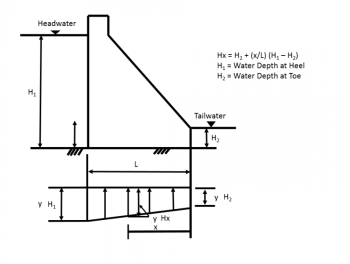Internal Stability (Stresses): Difference between revisions
Rmanwaring (talk | contribs) (Created page with "<!-- Delete any sections that are not necessary to your topic. Add pictures/sections as needed --> __NOTOC__ ---- {| align="right" style="width:10%;" cellpadding="7" | 350px|x350px|link=https://damfailures.org/lessons-learned/concrete-gravity-dams-should-be-evaluated-to-accommodate-full-uplift/ |- |style="text-align:center; font-size:90%;"| Learn more about the need to consider uplift pressure when designing a gravity structure at [...") |
No edit summary |
||
| Line 1: | Line 1: | ||
<!-- Delete any sections that are not necessary to your topic. Add pictures/sections as needed --> | <!-- Delete any sections that are not necessary to your topic. Add pictures/sections as needed --> | ||
__NOTOC__ | __NOTOC__ | ||
[[Category:Global Stability of a Dam]] | |||
---- | ---- | ||
{| align="right" style="width:10%;" cellpadding="7" | {| align="right" style="width:10%;" cellpadding="7" | ||
Revision as of 05:37, 18 November 2022

|
| Learn more about the need to consider uplift pressure when designing a gravity structure at DamFailures.org |
"Water pressures caused by reservoir water and tailwater occur within the dam and foundation in pores, cracks, joints, and seams. The distribution of internal water pressures along a horizontal section through the dam or its foundation is assumed to vary linearly from full reservoir pressure at the upstream face to zero or tailwater pressure at the downstream face in the absence of drains or a more detailed analysis."[1]
"The internal water pressure, also called uplift, acts to reduce the compressive stresses normal to a horizontal section through the dam. Including a line of vertical formed drains within the dam and parallel to the upstream face serves to reduce the uplift force. The uplift reduction is dependent on the size, location, and spacing of the drains.[1]
"Forces from water pressures also occur within the foundation. Uplift forces in the foundation decrease the normal forces occurring on potential sliding planes. Water forces occurring on high angle joints increase driving forces on foundation blocks. Both of these reduce foundation sliding stability.[1]
"The uplift forces within the foundation and along the foundation-dam contact can be reduced by a line of drain holes drilled into the foundation from the floor of the foundation gallery. The internal pressure distribution through the foundation depends on depth, location, and orientation of the drains, rock permeability characteristics, jointing, faulting, and any other geologic features that may modify the flow. The line of drains should be located a distance downstream from the upstream dam face that will ensure that direct connection from the reservoir will not occur."[1]
Examples
![]() Case study: Oroville Dam Spillway Incident (Damfailures.org)
Case study: Oroville Dam Spillway Incident (Damfailures.org)
![]() Case study: St. Francis Dam Failure (Damfailures.org)
Case study: St. Francis Dam Failure (Damfailures.org)
Best Practices Resources
![]() Stability Analysis of Concrete Structures (EM 1110-2-2100), USACE, 2005
Stability Analysis of Concrete Structures (EM 1110-2-2100), USACE, 2005
![]() Gravity Dam Design (EM 1110-2-2200), USACE, 1995
Gravity Dam Design (EM 1110-2-2200), USACE, 1995
![]() Arch Dam Design (EM 1110-2-2201), USACE, 1994
Arch Dam Design (EM 1110-2-2201), USACE, 1994
![]() Design of Small Dams, USBR, 1987
Design of Small Dams, USBR, 1987
Trainings
![]() On-Demand Webinar: Introduction to Concrete Gravity Dams
On-Demand Webinar: Introduction to Concrete Gravity Dams
![]() On-Demand Webinar: Uplift and Drainage for Concrete Dams and Spillways
On-Demand Webinar: Uplift and Drainage for Concrete Dams and Spillways
![]() On-Demand Webinar: Analysis of Concrete Arch Dams
On-Demand Webinar: Analysis of Concrete Arch Dams
![]() On-Demand Webinar: Stability Evaluations of Concrete Dams
On-Demand Webinar: Stability Evaluations of Concrete Dams
![]() On-Demand Webinar: Roller Compacted Concrete - Design and Construction of Water Control Structures
On-Demand Webinar: Roller Compacted Concrete - Design and Construction of Water Control Structures
Citations:
Revision ID: 4480
Revision Date: 11/18/2022
